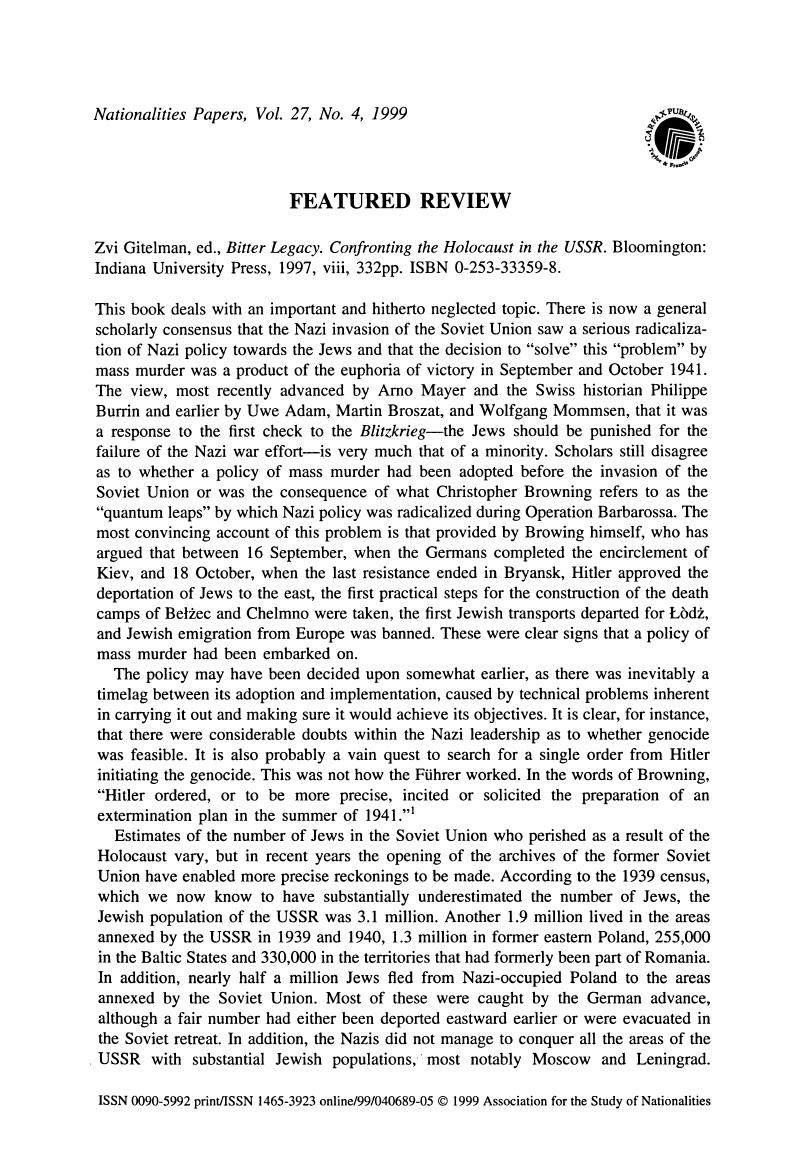No CrossRef data available.
Published online by Cambridge University Press: 20 November 2018

1. In David Cesarani, ed., The Final Solution. Origins and Implementation (London: Routledge, 1994), p. 117.Google Scholar
2. Arad, Yitzhak, “The Holocaust of Soviet Jewry in the Occupied Territories of the Soviet Union,” Yad Vashem Studies XXI (Jerusalem: Yad Vashem, 1991), p. 47.Google Scholar
3. Ilya Ehrenburg and Vassili Grossman, eds, The Black Book of Soviet Jewry (NewYork: Schocken Books, 1981).Google Scholar
4. Lucjan Dobroszycki and Jeffrey Gurock, eds, The Holocaust in the Soviet Union. Studies and Source on the Destruction of the Jews in the Nazi-Occupied Territories of the USSR (Armonk, NY: M. E. Sharpe, 1993).Google Scholar
5. Levin, Dov, The Lesser of Two Evil: East European Jewry under Soviet Rule, 1939–1941 (Philadelphia: JPS, 1993).Google Scholar
6. Braham, Randolph, ed., The Tragedy of Romanian Jewry (Boulder: Social Science Monographs, 1994); Randolph Braham, ed., The Destruction of Romanian and Ukrainian Jewry during the Antonescu Era (Boulder: Social Science Monographs, 1997).Google Scholar
7. Among the more interesting contributions to this debate are Taras Hunczak, “Ukrainian–Jewish Relations during the Soviet and Nazi Occupations,” in Yuri Boshyk, ed., Ukraine during World War II: History and Aftermath (Edmonton: Canadian Institute of Ukrainian Studies, 1986), pp. 39–57; Yaroslav Bilinsky “Methodological Problems and Philosophical Issues in the Study of Jewish Ukrainian Relations during the Second World War,” in Howard Aster and Peter Potichny, eds, Ukrainian–Jewish Relations in Historical Perspective (Edmonton: Canadian Institute of Ukrainian Studies, 1988); Shmuel Spector, “The Attitude of the Ukrainian Diaspora to the Holocaust of Ukrainian Jewry,” in Yisrael Gutman and Gideon Greif, eds, The Historiography of the Holocaust Period (Jerusalem: Yad Vashem, 1988); A. Vais, “Otnoshenie nektotorykh krugov Ukrainskogo natsional'nogo dvizhenia k Evreiam v periood vtoroi mirovoi voiny,” Vestnik Evreiskogo Universiteta v Moskve, Vol. 2, No. 19, 1990; John-Paul Himka, “Ukrainian Collaboration and the Extermination of the Jews during the Second World War: Sorting out the Long-term and Conjunctural Factors” Studies in Contemporary Jewry, Vol. 13, 1997, pp. 170–189. Basil Dmytryshyn, “The SS Division ‘Galicia’: Its Genesis, Training, Development,” Nationalities Papers, Vol. 21, No. 2, 1993, pp. 53–75.Google Scholar
8. Korey, William, “Anti-Semitism and the Treatment of the Holocaust in the USSR/CIS,” in Randolph Braham, ed., Anti-Semitism and the Treatment of the Holocaust in Postcommunist Eastern Europe (New York: Columbia University Press, 1994), p. 209.Google Scholar
9. Quoted in John Garrard, “The Nazi Holocaust in the Soviet Union: Interpreting Newly Opened Russian Archives,” East European Jewish Affairs, Vol. 25, No. 2, 1995, pp. 8–9.Google Scholar
10. Braham, The Tragedy of Romanian Jewry; The Destruction of Romanian and Ukrainian Jewry during the Antonescu Era .Google Scholar